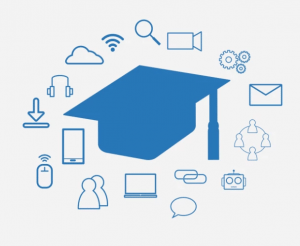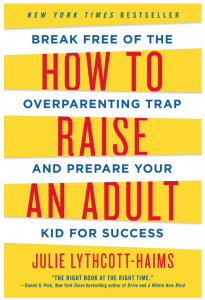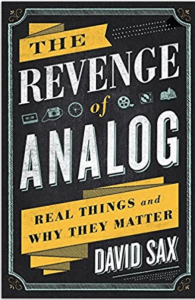 Many of us struggle with the role of technology in the lives of our students and within the culture of our organizations, and even in our own lives. I’ve been thinking about this throughout this year, and was able to capture some of my earlier thinking in this BLOG POST of an Email conversation with @edaigle. Since then, I’ve done some design thinking at my own school to arrive at a question, and a potential solution.
Many of us struggle with the role of technology in the lives of our students and within the culture of our organizations, and even in our own lives. I’ve been thinking about this throughout this year, and was able to capture some of my earlier thinking in this BLOG POST of an Email conversation with @edaigle. Since then, I’ve done some design thinking at my own school to arrive at a question, and a potential solution.
Question: How might we limit personal device use to promote wellness and community.
Personal devices are defined as a technology that is used for personal social purposes. It could be computers, smartphones and even watches. It is important to see that the idea of limiting their use, is not the limiting of their possession of them nor their access to wifi and specific sites.
So, over the course of the year from January to June, using the tenants of Adam Fletcher’s work on Meaningful Student Involvement, we were able to bring together a group of students and faculty and administrators to explore and co-create an answer this question. We are going to try out our response this coming year.We are looking to limit these devices in space and times of the school that are intentionally designed for meaningful face-to-face interactions.
Answer: At specific times in specific places between formal academic times personal device use is not permitted. Sharing meals in public spaces is an intentional community-building time we view as opportunities to meet with friends, peers and new community members. The intention of this policy is to promote community and overall wellness. These guidelines will be supported with educational programming.
This is a cultural shift, and for the first time since I’ve been at the school it is putting a stake in the ground delineating what we value when it comes to technology use. I feel that this is an important moment for the school community, and I’ve been reading on how to best articulate our “WHY”.
Julie Lythcott-Hains
 I’ve been reading and watching Julie Lythcott-Hains and her work around “How to Raise an Adult”. If you haven’t see her TED talk, you should check it out. It is more about parenting in general, but in her exploration of “Check-listed Childhood” she has some great connections to how parents use technology as a leash, as a way to hover over their children, and children turn to technology to get away from said childhood.
I’ve been reading and watching Julie Lythcott-Hains and her work around “How to Raise an Adult”. If you haven’t see her TED talk, you should check it out. It is more about parenting in general, but in her exploration of “Check-listed Childhood” she has some great connections to how parents use technology as a leash, as a way to hover over their children, and children turn to technology to get away from said childhood.
David Sax: The Revenge of Analog
David Sax is a close personal friend of @adamcaplan, and you can see how Adam’s

care, concern and thoughtful approach to all things helped to inspire this book. It explores and “…Extols the Superiority of Real Things” and its connection to what we are trying to do at my school are so valuable. Here are some great quotations that I am using to help me articulate our WHY:
– Pg. 80 “A Twitter conversation is nothin more than a chain reaction of highly edited quips; a Facebook friendship is ore like an electronic Christmas card exchange than a real interaction; an Instagram feed captures jus the shiny highlights of life. “Networked, we are together, bot so lessened are our expectations of each other that we can feel utterly alone,’ wrote professor of sociology and psychology Sherry Turkle in her book Alone Together. “And there is the risk that we come to see others as object to be accessed – and only for the parts we fine useful, comforting or amusing. Once we remove ourselves from the flow of phyicall, messy, untidy life….. We become less willing to get out there and take a chance’.”
– Pg. 220 After writing about his visits to some of the top digital companies in the U.S. like Facebook, Twitter, Pintrest, Amazon and others, David Sax writes, “These companies are not turning to analog out some Mad-Men-inspired nostalgia for the way business was done, or because the people working there are afraid of change. They are the most advanced, progressive corporations in the world. They are not embracing analog because it is cool. They do it because analog proves the most effecient, productive way to conduct business. They embrace analog to give them competitive advantage.”
* Some of the analog adoptions being made by these companies:
– Percolate (US Software company): banned all digital devices from meetings
– Yelp and Medium: create strong interpersonal corporate culture, bound by real relationships through tools that work against isolation. They do this by maintaining and increasing the use of white boards, and not moving collaboration into the digital landscape for example.
– Amazon: Jeff Bezos requires his direct reports to create a 6-page maximum report that each participant in the meeting read silently before they begin. No devices allowed, the reports are printed
– Pg. 238: “‘The digital world also bring dysphoria – a low-level but constant heartbreak that is one of its most controversial side effects’, wrote Virginia Heffernan in the New York Time Magazine in 2011… ‘.The magic of the internet is not working for everyone’.”
– Pg. 238: “‘Move Fast and Break Sh*t,’ the posters at Facebook say. Okay, great, everything’s broken. Can we slow down for a second and maybe fix it”
– Pg. 239: “As more research come out about the ffect of omnipresent digital technology, we are choosing analog for our health. Screen time has been proven to sap concentration, increase stress and anziety, wreak havoc with our sleep patterns, and disturb a whole host of brain functions. This is especially true in children…Analog allows us to step back from this…and reassert our sense of who we are.”
– Pg. 240 “The MIT professor Sherry Turkle, who has devoted her career to studying and writing about the impact of digital technology on our lives, once wrote that sociable technology always disappoints, because it promises what it cannot deliver. ‘It promises friendship but can only deliver performance’.”
These are powerful statements that help me to articulate our “WHY” for moving to these analog moments of time. This is going to be a cultural shift that students, parents and faculty (me included!) are going to find difficult. What strategies are there to promote this cultural change? Here is what we are thinking:
– Having signage that is not frame negatively. We’ve all seen the No Cellphones Allowed signs. Well, our signs are going to emphasize the benefits of face-to-face interactions.
– Signs will have the “WHY” as well. Some significant quotations and stats perhaps. We will see where we land.
– Analog options: providing games, puzzles and the like that promote face-to-face interaction will help prompt students to avoid personal device default behaviour.
– Guest Speakers to support this cultural shift. We are looking to partner with “The Generator Project” to help deepen our message
– Working with our student leaders and those who were involved in our working group to help us spread the message throughout the school
If’d love to hear how your schools and you articulate your “WHY” on this issue, and any strategies that have brought you success.
Great post, Garth, and thanks for your kind words.
I love your idea to create signs that communicate the desired behaviour instead of framing a negative one. Students are sensitive to spin, but they are also sensitive to vibe, so tone matters.
Thank you also for creating phone-free zones in the name of strong person-to-person relationships and the skills of attention.
Thanks @adamcaplan as always. Tell me, what does your school have in place around this technology use?
Love this, @gnichols. I think that the focus on face-to-face interaction, especially in certain areas, and the positive spin on the instructions, are so great. Not banning personal technology outright but creating reasonable boundaries for its use will go a long way, I’m sure. I look forward to hearing how it goes next year!
Jen
This is a wonderful endeavour that you have undertaken on a very prescient issue Garth! Just yesterday, France banned cell phones in all schools (https://www.bbc.co.uk/programmes/p06kdr79). I think I prefer your approach as it is co-created with all stakeholders involved, and more importantly, focuses on the “why” as the driving force behind the initiative. I think that when you “lead with the need”, good things happen. I hope this experiment results in students valuing their face-to-face interactions, and culminates in youth wanting to spend less time on their phones, as opposed to being forced too.
This year, we moved to create cellphone-free classrooms throughout the school, from 8:30-3:30, and phone-free lunches for our Grades 7’s and 8’s. The change is a start, and it seems well received.
@gnichols this is a wonderful post and very timely for us too. We are working / iterating on policy around this at BH too. I also love the positive spin and emphasis placed on creating community over lunch etc. I think it also resonates with students that we want them to slow things down and take a break. I think there are many students out there who will welcome the encouragement to be offline. Thank you for providing many references for further reading!
Thanks to @mbrims @acampbellrogers and @jweening for your comments. We are off to a great start, I think. We have some really beautiful signs now posted, and some great ideas yet to come!